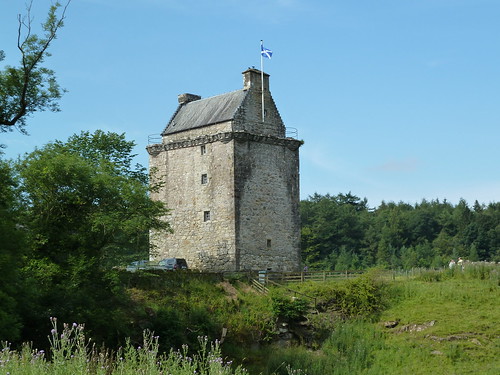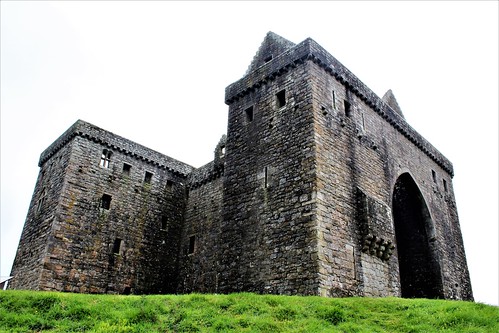Border Reivers
Scotland's Border Reivers
For a period of about 300 years ending in the early 17th century, the Scottish Borders region was a lawless area dominated by a number of warring families in a region which at the time was known as the 'Debateable Land', i.e. an area whose ownership was disputed (between England and Scotland).
The key areas were Liddesdale, Redesdale and Tynedale. During the medieval period this border region was generally wild, lawless and economically poor. These conditions triggered self-preservation centred on family groups or clans whose allegiances fluctuated but not necessarily to the national governments of Scotland or England. Reiving is a term used to describe raiding for cattle, sheep and any other assets which were mobile or could easily be transported. In the locality, reiving was a way of life, practised by all social classes and not viewed with discredit.
Reiving had its origins in the constant warring between England and Scotland dating from the 14th century. The border areas of Scotland were subject to devastating invasions by the English and became a buffer zone between two belligerent neighbours turning the area into a political and economic wasteland, a situation which lasted for a period of over 300 years. In these lawless times, the English raided the Scots, the Scots raided the English and the various Reiver families raided each other. The situation was aggravated by inefficient government and corrupt officials. In essence, families like the Graemes, Armstrongs, Elliots, Routledges, Nixons, Bells Douglasses, Hepburns, and Scotts became too powerful and were left alone by the government. It actually suited the respective governments of England and Scotland to have a “buffer” zone between the two countries.
In this pre-industrial era, most reiving was carried between Lammas (August 1st) and Candlemas (February 2nd.), i.e. after the harvest had been gathered and when the horses and been fed and in good condition for the long-distance raiding.
Reiving was brought to an end in the early 17th century when James VI of Scotland became James I of England and initiated a policy of unification. The term ‘Borders’ was forbidden and thereafter to be known as the Middle Shires. A policy of ruthless law enforcement was initiated, particularly targeted at the reiving families who were dispossessed of their lands, hunted down, executed where appropriate and forbidden from carrying weapons. This policy proved successful in that the rule of law was imposed but the downside was the scattering of many former proud family groups to England, Ireland, America and elsewhere. Like America’s Wild West, the reiving period gave rise to a legacy of famous characters such as Kinmont Willie, Wat of Harden, Little Jock Elliot, Lang Sandy and Johnnie Armstrong of Gilnockie.
The Reiver Trail
A location worthy of consideration as a base for connecting with the reiving era is Langholm, a small country town which is situated about 78 miles south of Edinburgh. Many of the sites below overlap with those mentioned in the separate section on Clan Armstrong to which readers should refer.This is because the Armstrongs were the dominant clan and have left the most extensive tangible legacy.
-Carlenrig, where the Scottish reiver, Johnnie Armstrong, met his death by hanging without trial. There are monuments to both his actual burying place and his life, with latter in nearby graveyard.
-Muckle Toon of Langholm. A pleasant Borders town wherein can be found both the ruins of Langholm Castle, built by the Armstrongs.
–Gilnlockie/Hollows which is one of the best preserved reivers towers house or ‘pele’. This may have been the home of the notorious Johnnie Armstrong.
-Memorial to Lang Sandy Armstrong at Rowanburn village. He was hanged along with his 11 sons in the early 17th century.
-Ettletown Cemetery with its Armstrong Memorial Wall. Also, a number of other Armstrong memorials including that of an Armstrong who was shot dead by a minister of religion without warning.
–Milnholm Cross, one of the oldest relics of the Armstrong Clan which extends to eight feet in height. The cross was erected to commemorate an Armstrong Laird who was killed at nearby Hermitage Castle.
–Liddesdale Heritage Centre at Newcastleton which has information on the Reiver era.
–Mangerton Tower, the 12th century seat of the Armstrongs and now a ruin by side of defunct railway line, past a holiday park.
-Kershopefoot to see the Tourneyholm site where English and Scottish prisoners were exchanged and arguments settled by single combat.
-The stunning Hermitage Castle, a massive edifice which stands isolated and austere in the rolling landscape. This must have proved a formidable fortress which had links with the Douglasses, Hepburns, Elliots and Scotts.
-Smailholm Tower which is located about five miles west of Kelso.and accessed over rough ground. Summary information on the Tower is provided below.
- A rectangular building constructed of black volcanic rock and red sandstone sitting atop a volcanic outcrop at a height of 650 ft above sea level.
- Founded in mid 16th century for the Pringles (or Hoppringles) with ownership later transferring to the Scotts of Harden from whom romantic novelist Sir Walter Scott is descended.
- The tower has five levels: Bottom two were intended for storage and top three for occupation. Surrounding the base was an outer wall or ‘barmkin’ six feet thick.
- Architecture is a function of the turbulent era in which it was constructed, defensive with gunholes.
- Over the years Smailholm was caught in various military activities and suffered from Border Reiving attacks.
- On a more peaceful note, Scottish romantic novelist Sir Walter Scott was brought to nearby Sandyknowe Farm as a child in the 1770s to recover from illness (probably polio). His time here inspired his subsequent writings, particularly the Minstrelsy of the Scottish Border(1802).







Comments
Post a Comment